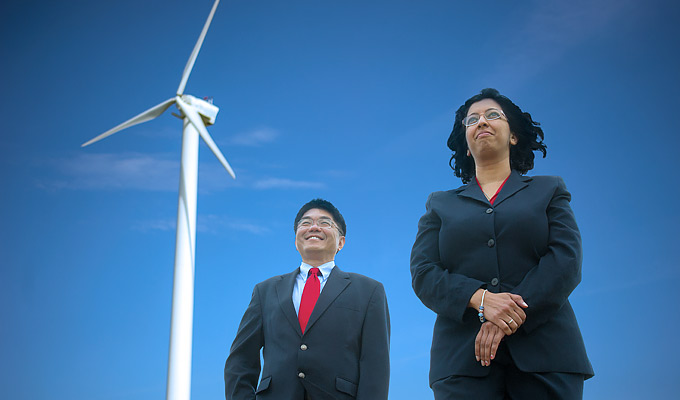They were right. The durability of the nickel alloy combined with a modified, more aerodynamic design allowed the windmill to operate under strong artificial winds without fracturing.
Rao’s daughter inspired the latter adjustment: “I saw her playing with her pinwheels one day, and I realized I need that same curvature to make the windmill move.” So she added a series of step-like levels on the blades to make them more aerodynamic.
Clean Energy Ingenuity
Rao and Chiao successfully demonstrated the micro-windmill in September 2013, then revealed it to the public a few months later. The device has since garnered an incredible amount of attention, being featured in The Washington Post, Time magazine, Wired, Fast Company, Forbes.com, National Geographic, and many foreign media outlets. Online videos showing the windmill were viewed almost a quarter-million times within the first three weeks alone.
Carolyn Cason, UT Arlington’s vice president for research, says she was both impressed and intrigued by the project.
“The first time I saw the micro-windmill, I said, ‘Wow…but what’s it good for?’” she recalls with a chuckle.
Rao admits she didn’t have a specific application in mind when she designed the device. The challenge for harnessing wind energy is that wind is not a constant weather condition. So the researchers needed to find applications that didn’t rely on constant airflow. A brainstorming session led to the most popular solution: cellphone batteries.
“Dr. Chiao and I were bantering about possible uses in his office one day,” Rao says. “I was really excited, waving my phone around as I was talking. And he looks at me and goes, ‘Do you realize what you can use the windmills for?’

J.-C. Chiao and Smitha Rao's invention brings a new dimension to wind energy.
With items like compact mobile devices, bursts of energy from the wind are able to provide enough stable power for the battery. In practice, the way it would work is that hundreds or thousands of windmills would be embedded within a device’s packaging to collect energy from the airflow in the environment. To charge their smartphones, users would simply put a sleeve onto the device, wave it in the air for a while, and then use it again.
But that’s just one of the micro-windmill’s potential uses. Both Chiao and Rao believe their creation eventually could power things like wireless sensors beneath bridges, highways, or buildings that monitor environmental and structural conditions. When dealing with those compact, hard-to-reach items, solar panels and micro-windmills could prove to be a more convenient energy solution than continually replacing batteries.
“There are so many challenges associated with remote locations, where electrical energy is not readily available,” Dr. Cason says. “I think the way in which they’re proposing to use the micro-windmill is quite intriguing.”
As an added bonus, the micro-windmills are also relatively cheap to make, since they are produced in an array using batch processes. The fabrication cost of making one device is the same as making hundreds or thousands on a single wafer, which allows for mass production of inexpensive systems.
Small Size, Big Future
So what’s next for the micro-windmill project? Both Rao and Chiao say a lot more investigation into just what makes the devices tick—and what problems they may face.
“When structures shrink down to tiny dimensions, the physics change,” Chiao explains. “Take water as an example. With large turbines, water is no issue. But with the micro-windmills, water molecules can keep the blades from turning. We really need to understand these types of fundamental issues before we can transfer the knowledge to professional engineers, who can optimize the design in industries.”
Rao knows that despite the success they’ve had with the windmill thus far, there is still much more research and experimentation to be done.
“When I designed it, it was mostly general calculations and pure intuition,” she says. “Now we know how we want to use the micro-windmill, so we need to start designing it from that perspective.”
Adds Chiao: “This invention is an enabler that can power many different types of compact devices. We’ve just begun to surf the wind.”
















